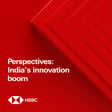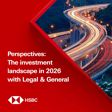Introduction to HSBC Global Viewpoint Podcast
00:00:00
Speaker
Welcome to HSBC Global Viewpoint, the podcast series that brings together business leaders and industry experts to explore the latest global insights, trends, and opportunities.
00:00:12
Speaker
Make sure you're subscribed to stay up to date with new episodes.
00:00:15
Speaker
Thanks for listening.
00:00:16
Speaker
And now onto today's show.
Meet Professor Jessica Translick
00:00:22
Speaker
Well, hi everyone and welcome to our EIG Talk series.
00:00:26
Speaker
Today, I'm very pleased to be joined by Professor Jessica Translick, who is in the Institute of Data Systems and Society at the MIT to discuss the progress of clean energy technologies.
00:00:39
Speaker
Jessica, thank you for joining us.
MIT Lab's Decarbonization Research
00:00:41
Speaker
It's great to be here.
00:00:42
Speaker
So today we were hoping to cover the progress of clean energy technologies.
00:00:48
Speaker
And especially with your scientific data-driven approach, how you think about it.
00:00:53
Speaker
Maybe we can start with some of the studies and research that you have worked on.
00:00:58
Speaker
So I run a lab here at MIT and we work on assessing different options for decarbonizing the economy.
00:01:07
Speaker
What we're interested in is understanding the role that technology can play and also how to invest strategically in technologies that can be very effective in drawing down greenhouse gas emissions while providing a good service and keeping costs low and so forth, minimizing overall environmental costs.
00:01:26
Speaker
impacts, et cetera.
00:01:28
Speaker
So that's what we work on.
00:01:29
Speaker
We develop bespoke data-informed models to investigate these questions with the goal of informing investment decisions.
00:01:37
Speaker
And I also offer online courses for a professional audience, and I consult for companies as well in helping them find a way to participate in this major transition that we're experiencing right now
EVs and Daily Transportation Needs
00:01:53
Speaker
Thank you very much.
00:01:54
Speaker
And looking at some of the research you have done, I think there was some interesting analysis into how much of the demand that we have for transportation with light vehicle could be covered by EVs without charging within a day.
00:02:09
Speaker
So how convenient currently EVs are for users.
00:02:13
Speaker
I think this research was for the US market.
00:02:15
Speaker
and then how much of the demand it can cover.
00:02:17
Speaker
And I think the number was quite high, actually.
00:02:19
Speaker
If you look at, you know, just a daily snapshot and you make the assumption that people have access to overnight charging, then, you know, on a typical day, most people will be able to go through their day, go about their activities without having to recharge.
00:02:37
Speaker
So if we look at the U.S., for example, a snapshot of the U.S., we take a low-cost EV,
00:02:43
Speaker
Within that US market, it's low cost relative to other cars in the US market.
00:02:48
Speaker
These are not the lowest cost EVs because there are many other markets where EVs are available at much lower costs.
00:02:54
Speaker
So if you take that daily snapshot, you see that upwards of between 90 and 95% of cars could be replaced by an electric vehicle without having to recharge during
00:03:06
Speaker
And if you look at a typical person, and most individuals fall within this range, you see that throughout the year on 90 to 95% of days, you don't have to recharge your car if you have one of these electric vehicles, even if it's one of the more affordable ones.
00:03:23
Speaker
And that's for the US.
00:03:24
Speaker
But those numbers are somewhat similar across many other markets as well, because they have to do with restrictions and the amount of sunlight, the sun rises, the sun sets, people need to sleep
Environmental Impact of EVs
00:03:35
Speaker
But of course, not everybody can charge overnight.
00:03:38
Speaker
You also need, if you're going to use this as your only vehicle, you want to be able to go on long distance trips, you need charging along those trips.
00:03:47
Speaker
And so that's where you really need fast chargers.
00:03:49
Speaker
Workplace charging is really important for managing grid impacts.
00:03:53
Speaker
So there are very strategic locations where you can put chargers.
00:03:57
Speaker
One of the key layers, though, is to put chargers in places where people park.
00:04:03
Speaker
when they're at home overnight, because then you can make those chargers lower power, minimal grid impacts.
00:04:10
Speaker
And most of the time, you don't even have to think about recharging your car during the day.
00:04:14
Speaker
So that's an example of some of these strategic solutions that you can identify through data-informed models.
00:04:20
Speaker
It's very promising, actually, in terms of when we think about the trend of adoption, the fact that currently, even with, as you say, lower end of the range, you can already satisfy a lot of the demand.
00:04:30
Speaker
And that's, you know, ignoring the improvement that you will have in batteries and their capacity.
00:04:35
Speaker
Patrick, I should mention is that, of course, no technology is perfect.
00:04:39
Speaker
So if we take the example of EVs, if you look at the environmental factors,
00:04:44
Speaker
You do improve substantially relative to internal combustion engine vehicles because you can mitigate
Challenges in Cutting Emissions by 50%
00:04:50
Speaker
some of the emissions from extracting fossil fuels and the environmental impacts of that.
00:04:56
Speaker
But you do also have to mine materials for those electric vehicle batteries.
00:05:01
Speaker
But when you look at the overall lifecycle assessment, there's still an improvement with the electric vehicles over the internal combustion engine vehicles, a very substantial improvement.
00:05:10
Speaker
But it is important to kind of acknowledge that no technology is perfect.
00:05:15
Speaker
And it's important to try to mitigate those negative environmental and social impacts in the
00:05:22
Speaker
And that's something we also focus on in our analyses.
00:05:25
Speaker
So I don't want to paint a completely rosy picture.
00:05:29
Speaker
There's still a lot of work to be done.
00:05:30
Speaker
Thank you, Jessica.
00:05:32
Speaker
From your research, it seems like there is a lot of data and models and capabilities basically to help model this and get to the transition.
00:05:40
Speaker
So I wonder what you think about where we are in terms of state of the play with regards to technology for the clean energy transition.
00:05:48
Speaker
Yes, this is a question that often comes up and many of you may have heard that we have many or even all of the technologies we need to reach net zero emissions.
00:05:59
Speaker
And it is true that we have a lot of the technological tools we need.
00:06:04
Speaker
We see that the assessment is that about 50% of overall emissions could be addressed with current technological tools that are cost competitive and scalable.
00:06:15
Speaker
But of course, you have only to look as far as the global greenhouse gas emissions trends.
00:06:22
Speaker
So if we look at CO2, for example, we see that FURB hasn't bent down yet.
00:06:27
Speaker
So emissions are still rising.
00:06:29
Speaker
So I just told you that about 50% of emissions could be addressed with current technological tools.
00:06:36
Speaker
based on this assessment, but we're not seeing that happening overnight.
00:06:40
Speaker
So we're not seeing that emissions curve drop down suddenly to 50% of where it was last year.
00:06:46
Speaker
In fact, in 2023, we hit a record high in carbon dioxide emissions.
00:06:52
Speaker
So what's the discrepancy between this technical potential and what's actually happening?
Success of Solar and Wind Investments
00:06:57
Speaker
Well, there are obviously hidden costs and inertia in the system that are preventing this change from happening overnight.
00:07:04
Speaker
That's not to say that these changes aren't happening.
00:07:06
Speaker
We do see technologies that are growing rapidly, like renewable energy, electric vehicles that are contributing to changing energy systems and enabling greenhouse gas emissions reduction.
00:07:21
Speaker
But this shift isn't happening as quickly as suggested by that technical potential that I mentioned a minute ago.
00:07:28
Speaker
So what are these hidden costs?
00:07:31
Speaker
Yeah, we can go into that a little bit.
00:07:32
Speaker
But just briefly to say, I think some of what's contributing to these hidden costs is what I call soft technology.
00:07:39
Speaker
So those are the costs of processes for making these changes.
00:07:43
Speaker
You also have other sources of inertia that we could perhaps talk about.
00:07:47
Speaker
I mean, I guess the bottom line is I would say we're in a good place.
00:07:51
Speaker
We have a lot of the technological tools we need, but more needs to be done to develop the new technological tools we need for that remaining 50% and also to enable the tools that we have to scale more rapidly to make them even more attractive in the marketplace.
00:08:09
Speaker
Thank you very much.
00:08:10
Speaker
And that makes me think about some technologies that have actually developed and scaled well with very strong decrease in the cost of production like solar.
00:08:21
Speaker
And so that leads me to ask you about what we have learned with regards to strategically investing in clean technologies and what can we apply from this to some of these other technologies that we need to develop in the future?
Future Technological Improvements and Investments
00:08:33
Speaker
Yeah, if we look at the clean energy technologies that we have, really the ones that have improved the most in recent years and recent decades are solar energy.
00:08:44
Speaker
Costs have fallen by more than 99% over the last four decades.
00:08:49
Speaker
And wind energy costs have also fallen.
00:08:52
Speaker
Electric vehicle batteries, namely lithium-ion battery, costs have fallen dramatically more than 97%.
00:08:59
Speaker
So these technologies have shown exponential improvement trends.
00:09:03
Speaker
And it's useful to look at where that came from.
00:09:07
Speaker
So this is something we work on quite a bit in my group, looking at what were the drivers of these rapid rates of improvement.
00:09:15
Speaker
And it's a combination of policies that drove a lot of private sector investment that led to substantial innovation technology improvement.
00:09:26
Speaker
There were many different mechanisms in each of those cases that contributed to technology improvement,
00:09:32
Speaker
One takeaway that we see from this, well, actually, let me talk about two takeaways.
00:09:37
Speaker
One is that there is predictive power in trends and past trends that can be used to estimate different rates of technology improvement across these technologies.
00:09:49
Speaker
And interestingly, actually, that predictive power wasn't used in many forecasts historically.
00:09:54
Speaker
So many forecasts underestimated the rate of improvement and growth in solar and wind energy, for example,
00:10:00
Speaker
But I think that can be used going forward.
00:10:03
Speaker
And then, you know, another takeaway that we see is that part of what led to this continuing improvement was continued investment in research and development on the part of companies, but also government investment in research and development played a role there.
00:10:18
Speaker
That's great insight.
00:10:19
Speaker
And I think what is interesting is that some of these technologies at the time, they were not price competitive and it was very difficult to foresee their trajectory.
Nuclear and Green Hydrogen's Role
00:10:28
Speaker
As you just said, some were not expected to move that fast, but thank you.
00:10:33
Speaker
Clearly a lot more to do.
00:10:34
Speaker
And some of the other technologies are there or are maybe still nascent.
00:10:40
Speaker
Maybe two I will want to ask you about.
00:10:43
Speaker
There was a target set triple nuclear capacity by 2050.
00:10:47
Speaker
And there's a lot of talk also about, you know, the small modular reactors.
00:10:51
Speaker
I think that's one question about nuclear.
00:10:53
Speaker
And the other question is about hydrogen, which is much less established.
00:10:57
Speaker
And there are question marks around, is it really going to happen?
00:11:00
Speaker
Is it really going to get to an industrial level when we can produce green hydrogen at the right price and in the right quantities?
00:11:06
Speaker
What do you think about those two?
00:11:08
Speaker
And do you think they are part of the solution to fill some of the gaps that you have?
00:11:12
Speaker
I do think both options can be very important and they're very different.
00:11:18
Speaker
So green hydrogen is something that many people are working on.
00:11:21
Speaker
Costs haven't come down enough yet for this to be used widely.
00:11:25
Speaker
Nuclear energy is used in many countries, or at least a number of countries, rely substantially on nuclear energy, and it's a significant contributor at the global level as well.
00:11:37
Speaker
But in many markets, costs have been rising.
00:11:40
Speaker
This is due to changes to soft technology that have led to these rising costs.
00:11:46
Speaker
In other markets, in Asian markets, data suggests that perhaps costs haven't been rising, though the data is quite limited.
00:11:53
Speaker
So it's an established technology in places where it's accepted, where people want it.
00:11:58
Speaker
I think it can be a real contributor today to reducing greenhouse gas emissions.
00:12:04
Speaker
It's really up to people in countries and regions whether they would like to have nuclear or not.
00:12:09
Speaker
And as you mentioned, many people are working on small modular reactors.
00:12:13
Speaker
The idea there is that some of the concerns that people may have could be addressed.
00:12:17
Speaker
We could bring costs down in places where costs have been rising.
00:12:21
Speaker
you could potentially also make regulation more streamlined, more centralized, more comfortable for people.
00:12:29
Speaker
So I think it's important to work on those technologies.
00:12:31
Speaker
What role they'll play in decarbonization is still unknown.
00:12:35
Speaker
So I would say it's unknown whether the small modular reactors will begin to grow, how quickly and so forth.
00:12:44
Speaker
So it's something I would keep in the portfolio.
00:12:46
Speaker
It's very important to do so because they could address
00:12:49
Speaker
a number of the challenges that it could be difficult to use electricity directly.
00:12:53
Speaker
So nuclear fission directly would not be a solution there, but it is a reliable source of electricity that could potentially be used to produce, to split water and produce
Importance of 'Soft Technology'
00:13:04
Speaker
Coming to hydrogen just really quickly here in the time we have left, I'll just say that this is something we're looking at in detail.
00:13:11
Speaker
The challenge can be that if you're using electricity to produce hydrogen, it's currently quite expensive, especially if you want reliable hydrogen, which is what most end users would want without interruptions.
00:13:25
Speaker
And if you're using steam methane reforming, you have substantial greenhouse
00:13:29
Speaker
gas emissions, and then you need to oversize your carbon capture and storage.
00:13:33
Speaker
And so there are challenges there.
00:13:34
Speaker
A lot of people are working on this progress is being made.
00:13:37
Speaker
I think it's definitely an important part of the portfolio that needs to be invested in, because if we can work it out, it's going to make a really big difference.
00:13:47
Speaker
It can be used in many different energy services, and it can be kind of the glue that weaves together a number of the other technological tools that we have, including, you know, solar
00:13:57
Speaker
and wind energy, batteries, nuclear fission where it's acceptable, hydro where it's available, and possibly even fossil fuels with CCS, with carbon capture and storage for some portion.
00:14:09
Speaker
Thank you for this.
00:14:10
Speaker
That was very insightful.
00:14:11
Speaker
And I think we will probably then close with a question that is forward looking.
00:14:16
Speaker
I think we'll be quite excited to hear about what do you think is the next frontier in terms of those technologies for the energy transition?
00:14:23
Speaker
There's a lot of exciting things happening.
00:14:25
Speaker
For me, one thing I'm really excited about going forward is, you know, the potential, as we talked about with hydrogen,
00:14:32
Speaker
you know, the potential to really put these technological tools together, weave them together, maybe with hydrogen, not just hydrogen, but other approaches as well, demand side management, that's something I'm really interested in.
00:14:44
Speaker
And then just generally soft technology, which is forms of codified knowledge that allow us to weave hardware together.
00:14:52
Speaker
So we're bringing hardware together through processes,
00:14:55
Speaker
effectively deploy hardware in the field, make the experience of using technology something that's enjoyable, that's productive.
00:15:03
Speaker
And so I think there's a lot of work we can do on soft technology.
00:15:06
Speaker
It's also the interface between hardware and humans.
00:15:08
Speaker
So this is something that I'm very excited about.
00:15:11
Speaker
Part of what's really slowing the energy transition down is the soft technology.
00:15:15
Speaker
It's the fact that
00:15:16
Speaker
There are so many delays in obtaining permits for projects, for interconnecting to grids and energy systems, and also the inefficiencies in acquiring customers and distributing information on what's possible that leads to less competitiveness in markets and overall inefficiencies.
00:15:35
Speaker
So I think it's really important, more than 50% of the costs of some solar systems and electric vehicle chargers
00:15:42
Speaker
are actually contributed by soft technology.
Conclusion: Overcoming Regulatory Complexities
00:15:45
Speaker
So I think that's a really important next frontier that I'm focusing on a lot.
00:15:49
Speaker
That's really, really interesting because it's not something we hear of a lot.
00:15:53
Speaker
As you say, it has a huge impact, in particular with some of the geopolitics that are happening and the tariffs and the regulation and the variability in the regulation across the world, which add to complexity and essentially to what you call soft technology and soft costs.
00:16:10
Speaker
which are become quite important component into the equation.
00:16:13
Speaker
So thank you for this.
00:16:14
Speaker
It has been very insightful and eye-opening.
00:16:17
Speaker
We look forward to the next conversation.
00:16:19
Speaker
Thank you, Jessica.
00:16:20
Speaker
Thank you so much, Patrick.
00:16:21
Speaker
This was a lot of fun.
00:16:24
Speaker
Thank you for joining us at HSBC Global Viewpoint.
00:16:28
Speaker
We hope you enjoyed the discussion.
00:16:30
Speaker
Make sure you're subscribed to stay up to date with new episodes.













